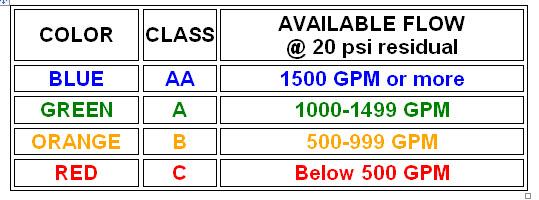Marking All Fire Hydrants
To fight a fire effectively, firefighters must be able to determine hydrant flows immediately upon arrival. Two things can greatly help with that determination: effective pre-incident planning and proper marking of fire hydrants. Fire hydrants should be immediately recognizable to firefighting forces as well as to the public.
Fire hydrants should be color coded to NFPA Standard 291, Recommended Practice for Water Flow Testing and Marking of Hydrants, 2022 Edition. Color-coded fire hydrants provide an immediate visual indication of available hydrant flow. Without color-coding, firefighters may not know the flow potential of a hydrant, especially if the firefighters are responding to a mutual aid call.
The hydrant barrel should be chrome yellow unless the jurisdiction has adopted another color for their hydrants (NFPA 291 § 5.2.1.1). Other highly visible colors used by communities include white, bright red, chrome silver, and lime-yellow. In jurisdictions where no standard color has been established, the most important aspect is consistency. Standard colors should be adopted which, preferably, are the same throughout the region.
Paint the top (bonnet) and nozzle caps (discharges) appropriate colors to indicate hydrant capacity (NFPA 291 Table 5.1 as referenced by NFPA 291 § 5.2.1.2).
Fire hydrant bonnets and caps shall be coded as follows (NFPA 291 Table 5.1):

NFPA recommends using reflective-type paint for easy identification at night (NFPA 291 § 5.2.1.3).
NFPA also recognizes that there are often functional differences in service provided by public (or municipal) and private hydrant systems. Therefore, NFPA specifies that non-municipal hydrants be painted a color that distinguishes them from municipal hydrants. Furthermore, violet has been established as the international color code for non-potable water. Therefore, hydrants supplied by non-potable sources should be painted violet (light purple).
The following body colors are recommended for fire hydrants:
| Supply | Body Color |
|---|---|
| Municipal System: | Chrome Yellow |
| Private System: | Red |
| Non-Potable System: | Violet (Light Purple) |
One of the biggest mistakes made in color-coding a hydrant is the failure to reduce the residual flow pressure to 20 psi. Many departments will color code the hydrant at whatever the flow was without taking time to chart or calculate the actual flow at 20 psi. This requires extra work but can mean the difference in color-coding in up to 50 percent of the hydrants in a given system.
NFPA 291 recommends stenciling the rated capacity of high volume hydrants on the top (NFPA 291 § 5.2.1.5).
